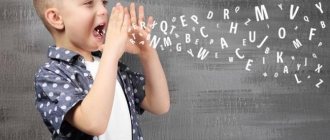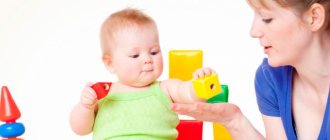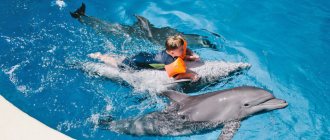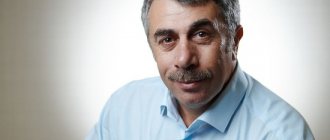When a non-speaking child comes to our center, for successful correction we must determine the cause of the lack of speech and understand the mechanism of the disorder. I say “we” because we usually look at “non-talkers” together with our speech therapist in the format of a comprehensive consultation. Each from his own side. Let's start from afar: does the child have hearing problems? What does the ENT say? In 99% of cases, the child is “hearing,” that is, hearing is defined as normal.
In order to see the speed of processing auditory impulses in the brain, there is a simple test: you can throw a thick book on the floor behind the child (one of my teachers does this). I just clap my hands loudly behind the child’s back at the most unexpected moment. Very often the child turns his head only after a few seconds (!). This is called slow orientation to sound. Remember yourself. If you suddenly hear a sharp loud sound behind your ear, your whole body will shake! Imagine how slow the processing of an auditory impulse is in a child if, firstly, the reaction is weakened (not the whole body shudders, but only turns around slightly), and secondly, not instantly, but after a while.
Next, we look at whether the child understands the spoken speech. To do this, we give various instructions, tests and observe how the child reacts, understands or does not understand, performs or does not perform. We deceive, we confuse. We give the same instructions in different versions: “show your nose, your bear’s, your mother’s, my nose!” And so on. We definitely ask parents to make a diagnosis using the ASVP (acoustic brainstem evoked potentials) and CEP (cognitive evoked potentials) methods. As a rule, sample results are confirmed by hardware examinations.
Often, when parents come to an appointment, they say that the child “understands” speech, but this is not confirmed by tests. The nuance here is that even animals “understand” human speech, but not in the way we think. For them, speech is not a set of semantic signs, but simply a kind of general noise signal to which they get used to reacting in one way or another. For example, dogs get used to the fact that after the word “walk” the owner will take the pet outside, so they run to the door. But if you say a similar-sounding word with a different meaning, they will react the same way. That is, this is the level of habit, “stimulus-response”, and not a meaningful and voluntary reaction to addressed speech. At approximately the same level, children with impaired recognition of addressed speech get used to “understanding” speech. However, any changes in the situation, wording, or change of interlocutor will cause confusion in the child.
Often such children behave like children with ASD. Imagine if you grew up in a speech vacuum. This leaves a strong imprint on the entire emotional, communicative sphere, cognitive development (in the absence of correction, secondary mental retardation develops), behavior (such children are said to be hyperactive, but their behavior problems are caused by the lack of internal speech, because speech is even internal does not develop, unlike pure motor alalia).
Impaired understanding of spoken speech may be caused by speech auditory agnosia and sensory alalia. Now it is fashionable to separate these two disorders in theory, but in practice we still rarely see pure sensory alalia without a violation of auditory speech perception.
How does auditory speech agnosia differ from sensory alalia?
I’ll tell you a little about the development of speech understanding in ontogenesis. At the age of up to 1 year, priority development occurs in the temporal region of the right hemisphere. That is, the child first of all matures the ability to holistically perceive non-speech (objective) noises (loudness, tonality, source, melody, rhythm, intonation). Non-speech noises also include sounds made by animals. This is the foundation for subsequent understanding of speech, which is why it is so important for children to provide a varied sound environment. As a result, the child develops his first onomatopoeias. In correction, speech therapists also use techniques to distinguish between various object noises to pass this stage of development (if it has been disrupted) and the subsequent formation of speech auditory gnosis.
At the age of about 1-1.2 years, the secondary fields of the temporal cortex of the left hemisphere are activated (they mature completely by 2 years). And in the noise stream the child begins to isolate speech sounds. His onomatopoeias acquire a “human” pronunciation, vocalizations, normative echolalia (repetitions of heard words), and interjections (oh, bang, bam) begin. This is not one sound, but a series of sounds and simple words that can already be used in a familiar context (mom, dad, baba). This is the stage of maturation of speech auditory gnosis. The child does not yet have the ability to understand the polysemy of words; context (necessarily substantive) is important. Immaturity of the secondary fields of the temporal cortex results in speech auditory agnosia . And if this stage has not been passed, then further development of speech understanding does not occur.
Next, the tertiary fields of the cortex mature - this is the zone where the “overlap” of the parietal, temporal and occipital cortices occurs. The so-called TPO zone. Or the posterior association cortex. And the words perceived by the secondary cortex begin to be saturated with different meanings, connected with each other, acquiring semantic shades and developing without a strict connection to one object. The child begins to master his native language. Among biological species, only humans have tertiary fields. Violation at this stage leads to sensory alalia.
The main practical problem is that the immaturity of the previous level of the auditory analyzer leads to underdevelopment of the next one. Sometimes it is impossible to clearly differentiate whether the formation of only secondary or tertiary fields at the stage is disrupted. And as hardware diagnostics using the evoked potential method shows, impulse conduction is often disrupted in children, not reaching the cortex at all! That is, in essence, they have mild sensorineural hearing loss, which was not identified in a timely manner. And if the impulse to the cortex comes with a delay and in incomplete volume, then the primary, secondary, and tertiary cortex suffer. Language acquisition and thinking are impaired.
Stages of speech development in children from 0 to 5 years old
Every parent should know that if you don’t work with your baby and don’t develop his speech, he will never speak on his own . But it is also worth remembering that the timing of the beginning of intelligible speaking is very individual. Some children confidently pronounce words at the age of one, while others can barely form syllables at three years of age.
There are certain age indicators by which one can see a delay in speech development:
- A three-month-old baby is characterized by humming;
- A six-month-old baby is characterized by babbling;
- As a rule, girls speak their first word at ten months , but boys only at one year of age;
- At one and a half years old, the “silent one” pronounces about 10–12 words, it all depends on how his parents or teachers dealt with him;
- A two-year-old child knows almost all pronouns;
- At three years old, the baby knows about 350–400 words, he easily pronounces them and freely expresses his emotions;
- By the age of four, a child knows more than one and a half thousand words;
- At five years - more than three thousand words.
What to do if a child does not understand speech?
At the “BEFORE” correction stage of the tertiary cortex (that is, with auditory speech agnosia), Tomatis is ideal for helping. This can be seen both in practice (the understanding of speech in children who did not even respond to their name is amazingly improved) and in the study of evoked potentials. Of course, auditory stimulation must be combined with speech therapy sessions, but even without them there is always a huge leap in speech perception.
And at the level of the tertiary cortex (when auditory speech gnosis is well formed), the help of a speech therapist is necessary for the development of language, the acquisition of polysemy of words, and the elimination of agrammatisms. And classes need to be taken regularly and for a long time.
By the way, the understanding of speech deficits that is closer to me is not discrete (there is speech, there is no speech, hence the term “alalia”, that is, absence of speech), but a continuous one, because even after the start of speech, the child continues to master the language system (that’s why I really like the term “dysphasia development").
Neuropsychologist Alexandrova O.A.
Child doesn't speak? Doesn't understand speech? Sign up for a consultation by phone or fill out the form on the website.
The role of parents in the treatment of SPD
Without the participation of mom and dad, even the best specialist will not be able to cure their child. Their task is to follow all doctors’ recommendations. For example, doing exercises at home to develop fine and gross motor skills, playing outdoor games, listening to and guessing musical instruments, putting together puzzles, constantly talking to the child - only with such comprehensive work of doctors and parents can he be helped.
Another important point. Do not replace verbal communication with TV and smartphone. The speech your child hears on TV or from cartoons interferes with the formation of his own speech. His passive vocabulary will be good, but his active vocabulary will not. “Mechanical” voices activate the right hemisphere when the left hemisphere is responsible for speech formation. Thus, gadgets inhibit speech development and provoke mental retardation, which, in turn, can lead to a delay in the mental development of speech. Therefore, it is better not to turn on the TV, radio, tablets and other devices at all in front of your child.
Spend more time with your son or daughter, go out into nature - this helps improve your psycho-emotional state.
Sources
- Wu Y., Li G., Zheng Y. . // Lin Chung Er Bi Yan Hou Tou Jing Wai Ke Za Zhi - 2021 - Vol35 - N4 - p.341-345; PMID:33794634
- Voitenkov VB., Komantsev VN., Klimkin AV., Ekusheva EV., Skripchenko NV., Bedova MA. // Adv Gerontol - 2021 - Vol33 - N5 - p.1002-1006; PMID:33550760
- Liu X., Zhong R., Kusuma L., Li N., Tang W. Determining social power: Do Chinese preschoolers integrate verbal and nonverbal cues? // J Exp Child Psychol - 2021 - Vol204 - NNULL - p.104943; PMID:33360276
- Ganc M., Kobosko J., Jedrzejczak WW., Kochański B., Skarzynski H. Psychomotor development of 4-year-old deaf children with cochlear implants: Three case studies. // Int J Pediatr Otorhinolaryngol - 2021 - Vol141 - NNULL - p.110570; PMID:33348125
- Fordington S., Brown T.H. An evaluation of the Hear Glue Ear mobile application for children aged 2-8 years old with otitis media with effusion. // Digit Health - 2021 - Vol6 - NNULL - p.2055207620966163; PMID:33194218
- Jasińska KK., Shuai L., Lau ANL., Frost S., Landi N., Pugh KR. Functional connectivity in the developing language network in 4-year-old children predicts future reading ability. // Dev Sci - 2021 - Vol24 - N2 - p.e13041; PMID:33032375
- Tan LT., Nathan AM., Jayanath S., Eg KP., Thavagnanam S., Lum LCS., Gan CS., de Bruyne JA. Health-related quality of life and developmental outcome of children on home mechanical ventilation in a developing country: A cross-sectional study. // Pediatr Pulmonol - 2021 - Vol55 - N12 - p.3477-3486; PMID:33002341
- Vilela N., Sanches SGG., Carvallo RMM. Development of auditory perception in preschool children. // Int J Pediatr Otorhinolaryngol - 2021 - Vol129 - NNULL - p.109777; PMID:31756662
- Wang J., Joanisse MF., Booth JR. Neural representations of phonology in temporal cortex scaffold longitudinal reading gains in 5- to 7-year-old children. // Neuroimage - 2021 - Vol207 - NNULL - p.116359; PMID:31733372
- Wu Y., Li G., Ma Y., Zheng Y. . // Lin Chung Er Bi Yan Hou Tou Jing Wai Ke Za Zhi - 2021 - Vol33 - N10 - p.918-922; PMID:31623034
Year three
The development of the child’s cognitive sphere “provokes” intensive development of speech. He is already repeating more complex words and even phrases, his vocabulary is actively expanding (by the age of 3 it is about 1000-1200 words). The baby is already making sentences from words, coordinating grammatical forms. The development of the phonetic system of the language also continues: the child learns to pronounce the sounds [s'], [z'], [ts'], [l']. However, the articulatory apparatus is not yet sufficiently developed, so the pronunciation of these sounds is not at all ideal. “Difficult” for the child are also hissing [w], [zh], [ch'], [sh'], which he can replace with soft or hard whistling ones (instead of “hat” he pronounces “syapka” or “sapka”, instead of “ beetle" - "zyuk"). The sounds [r], [r'] and [l'] are also absent in speech (sometimes children replace them with [l'] or [th]: “ul” (steering wheel), “dvel” (door), “may "(chalk). But the labial, middle and back lingual consonants ([p], [p'], [b], [b'], [m], [m'], [f], [f'] , [v], [v'], [k], [k'], [g], [g'], [x], [x'], [t], [t'], [d], [d'], [n], [n']) should already be correct.
If by the age of three your child does not speak or speaks very little , this is already a reason to worry and determine the reason for such a delay. The delay can be due to both physiological reasons (diseases of the ENT organs, physical exhaustion caused by serious illnesses, damage to the central nervous system accompanied by mental retardation) and psychological reasons (lack of communication and attention from adults). In any case, you should contact specialists as soon as possible. After all, the longer the period of developmental lag, the more difficult it is to catch up.
Nursery rhymes and jokes
In a sense, various nursery rhymes and jokes are ideal first literary texts that a child perceives literally with mother’s milk. After all, they describe real life experiences, the world around them, comment on various natural phenomena, etc. At the same time, the clear rhythm and melodiousness of nursery rhymes help the child easily learn new concepts and sometimes do what he doesn’t really want, but is necessary. For example, you can wash your face with this nursery rhyme:
- Some water, some water, wash Vanya’s (Masha’s) face,
- To make your cheeks blush, your eyes to shine,
- So that the mouth laughs, so that the tooth bites.
At the same time, we will teach the first lesson on the structure of the body and show where our face, cheeks, eyes, mouth and teeth are. Then, after washing your face, you can repeat the nursery rhyme again, this time depicting how to wash your face, not forgetting about your eyes or cheeks.
Your baby is a little one, and feeding him is a big problem? Perhaps another nursery rhyme will come to the rescue:
- The donut, the flatbread, was sitting in the oven, looking at us, and wanted to put it in her mouth.
Or this:
- I’ll bake Tanya a pie,
- I’m already blushing for my granddaughter.
- It has a wheat crust,
- And the filling is egg,
- And the honey shaving brush,
- My granddaughter is in trouble.
- These nursery rhymes can be read while eating.
- When putting a shirt on your baby, say:
- Aunt Agashka, sew me a shirt:
- I need to dress up and go for a ride!
They also tell nursery rhymes about natural phenomena. For example, about rain:
- Rain, rain, more!
- We'll give you the grounds
- We'll give you a spoon:
- Sip a little!
And try to “drive away” the lingering rain with this nursery rhyme:
- Rain, rain,
- Pour it full,
- Get the little kids wet!
Nursery rhymes also emphasize the baby’s new skills: for example, learning to walk:
- Katya, Katya, little,
- Katya is remote,
- Walk along the path
- Stomp, Katya, with your little foot.
Or:
- Bunny, walk around,
- Gray, walk around,
- Like this, like this
- Like this, like this!
The first steps, of course, cannot be imagined without numerous falls and bruises. Stroke the bruised area, saying:
- The cat is in pain
- The dog is in pain
- And Andryusha is not in pain,
- Andryusha's pain will fly away to the birch tree.
In this kind of nursery rhymes there is, among other things, a deep psychotherapeutic meaning. They allow you to take your mind off the pain, and therefore relieve the tension associated with pain. Such psychological treatment is quite effective for the baby.
By the way, did you know that perhaps the most famous finger game, “Magpie-Magpie,” did not end with the wiggling of the idle little finger:
- You didn't chop wood
- Didn't carry water
- There will be no porridge for you.
The game has a sequel. Adult says:
- I went looking for it myself:
- The water here is cold (stroking the baby’s wrist),
- It’s warm here (stroking her elbow),
- It's hot here (stroking her shoulder),
- And here - boiling water, boiling water, tickling! (adult tickles child under arm)
After all, the point of this nursery rhyme is not only the development of fine motor skills. It gives the child the joy of physical contact, the opportunity to feel his fingers, elbow, shoulder, and ultimately, to form an idea of his body.
There are special nursery rhymes for putting a child to sleep. They can become part of your ritual that gets your baby ready for bed. For example, you can put a fluffy toy kitten in the crib, which will “cradle” its little owner:
- Come, little kitten,
- Come, little gray tail,
- Come, cat, spend the night,
- Come and play with Dashenka.
- How am I for you, cat?
- I will pay for the work:
- I'll sew a new fur coat
- And I'll order boots.







